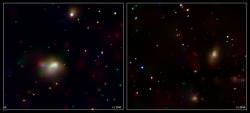The newest image released from NASA’s Chandra X-Ray Observatory is helping astronomers build up a census of the number of actively feeding supermassive black holes across the Universe. Scientists are hoping to build up a comprehensive picture of where (and thus when), these black holes were blasting out radiation.
It’s now thought that almost every galaxy in the Universe seems to contain a supermassive black hole at its centre. Perhaps the black holes came first and the rest of the galaxy formed around it, or maybe things evolved the other way around. Whatever the case, most of these black holes are in a quiescent state; apart from their gravitational influence on nearby stars, they’re all but invisible.
From time to time, however, the space surrounding these black holes flares up. Material falling into the black hole chokes up, and spreads out into a rapidly rotating accretion disk. Although the black hole itself is invisible, it’s this blocked up matter waiting to be consumed that shines hotly in the most energetic wavelengths.
This latest survey, gathered by NASA’s Chandra X-Ray Observatory seems to indicate that younger, more distant galaxy clusters contained many more active nuclei than the ones we see closer to us (and thus, closer to our current time). The more distant sample contains galaxies seen when the Universe was only 58% of its current age, while the closer sample shows galaxies at 82% of the galaxy’s current age. The more distant sample had 20x the number of active nuclei over the closer sample.
The research seems to point that the early Universe was much more likely to contain active galactic nuclei. This makes sense, since there was much more gas and dust in galaxies back then. This material was able to fuel the supermassive black holes. The research also points to a time in the future when there’ll be much less material to feed the black holes. It will become rarer and rarer to see these events.
Original Source: Chandra News Release

